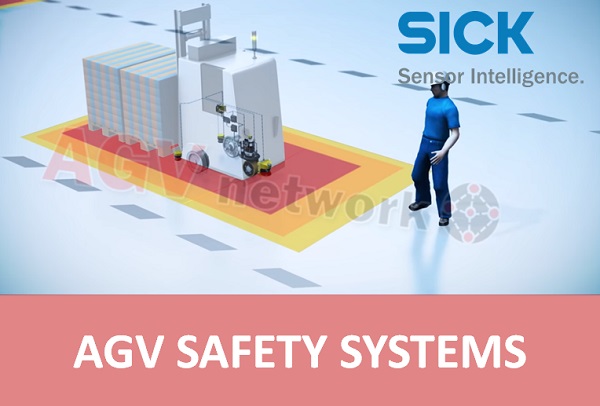The 7 AGV Components That Bring Autonomous Robots to Life
There is a wide variety of configurations available for AGVs. Regardless of the form they take, all automated guided vehicles are constructed with the same fundamental parts, which give them the ability to function and carry out their tasks in an effective and risk-free manner.
In this article, I will explain you what are the main parts of an automated guided vehicle.
What are the main components of an AGV?
These are the core automated guided vehicle components:
- The Safety System
- The Navigation System
- The Vehicle Control System
- The Motion System
- The Power System
- The User Interface System
- The Connectivity System
Imagine a well-rehearsed orchestra in which each member plays its part with consummate skills and the ensemble sounds absolutely beautiful.
Now, picture an AGV as a comparable ensemble, in which diverse systems collaborate to produce a masterpiece of automation that is reliable, efficient, and safe.
The AGV Safety System
Let's talk about the safety features first. First and foremost, safety.

Picture by Sick
The purpose of an AGV's safety system is to prevent damage to people, objects, and the environment while the vehicle is in use.
I have written a couple of articles about safety, check them later on... but finish this one first????.
???? Navigating AGV Safety Standards: A Comprehensive Guide
???? The Evolution of Autonomous Mobile Robots Safety: Understanding ANSI/RIA R15.08
Let's go: The safety system's job is to keep the AGV operating smoothly and safely so that any potential for harm is eliminated or reduced to a minimum.
The safety system employs sensors including lidar, cameras, and ultrasonic sensors to identify and avoid potential hazards.
Depending on its settings, an AGV may either wait for the obstruction to be removed or go around it using on-the-fly route planning.
It keeps a close eye on the AGV's speed and may modify it based on its immediate surroundings, guaranteeing that the vehicle never exceeds safe speeds in any circumstances.
The safety system has emergency stop buttons that may be used manually in the event of a major threat being recognized. When the emergency brake is applied, the AGV stops quickly yet safely, avoiding potential harm.
Preventing collisions is one of the primary functions of the AGV's safety system, which is responsible for constantly monitoring the environment and the vehicle's distance from obstacles and humans. In certain cases, this may need completely halting the AGV in its tracks.
????????♂️ By the way... if you really want to know more about AGV Safety... you cannot miss my withepaper with tons of deep info about this important topic (of course it's free)

| Click here to download the whitepaper |
The AGV Navigation System
There are several types of agv navigation systems, each one with its own pros and cons.
Anyway, regardless the navigation technology, the AGV navigation system is in charge of localizing and navigating the vehicle through its surroundings by assuring precise location, route planning, and path following.

It also communicates with other AGV systems, such as safety and vehicle control, to ensure seamless operation.
The following sensors are commonly used in AGV navigation systems:
- Magnetic sensors or RFID readers: They are employed in classic navigation systems to track tangible markers on the floor such as magnetic tape or RFID tags.
- LiDAR or laser scanners: With more complex navigation systems, such as agv natural navigation or laser triangulation (LGV Vehicles), these sensors are critical for recognizing obstacles, producing maps, and localizing the AGV.
- Cameras or other optical sensors: These sensors are used in vision guiding systems to recognize landmarks or objects in the surroundings and aid in calculating the AGV's location.
- Other IMU sensors provide more data to help to calculate the correct position and trajectory.
The AGV Vehicle Control System
The AGV vehicle control system is in charge of directing and coordinating the vehicle's motion precisely and effectively.
The primary functions of the vehicle control system are as follows:
AGV's speed regulation based on info provided by the navigation and safety sensors . The speed may be adjusted by the control system during curves, restricted passages, or while approaching other vehicles or people.
The control system is manages the AGV's actuators, such as motors, brakes, and steering mechanisms, in order to execute the planned motion and ensure the vehicle follows the desired route.
It also monitors the vehicle's systems for any abnormalities or failures and taking necessary steps, such as halting the AGV, informing operators, or modifying the vehicle's behavior, to ensure safety and performance.
The Motion System
The AGV motion system is made up of mechanical and electrical components that propel the vehicle by converting commands from the control and navigation systems into physical motion.
Its primary roles are as follows:
- Propulsion: Electric motors provide the driving force for the AGV's movement.
- Steering: Controlling direction by adjusting the orientation of the wheel or track.
- Braking: Slowing or halting the AGV when it is necessary for safety or job completion.
- Load handling is the management of components such as forks or conveyors to ensure effective material transfer.
- Suspension and stabilization: Maintaining stability and balance, particularly when carrying weights or over uneven ground.
The Power: Battery and Charging System
An AGV's battery and power system is in charge of delivering the energy required to power the vehicle's different components and guarantee smooth, uninterrupted operation.

This is a very interesting topic, the battery and its charging system can dramatically change the overall agv system performance. Again, if you wish to know more about the batteries for mobile robots, do not miss these articles.
???? AGV Batteries: Balancing Cost, Performance, and Reliability
???? Maximizing Efficiency and Minimizing Downtime: Best Practices for AGV Battery Charging Systems
This system's primary responsibility is to store, manage, and deliver electrical energy to the AGV's motors, sensors, and control systems.
The following are important battery and power system components:
- Battery: The major energy source for the AGV is often a rechargeable battery, such as lithium-ion, which allows it to function for extended periods of time before needing to be recharged.
- Battery management system (BMS): Monitors and manages the performance of the battery to ensure optimal charging, discharging, and general health, hence extending the battery's lifespan.
- Power distribution is a network of electrical components that distributes power from the battery to various systems such as propulsion, navigation, and control.
- Charging system: Allows the AGV to recharge its battery by manual charging, opportunity charging, or automated charging stations, reducing downtime and increasing operating efficiency.
The battery and power system are key components of an AGV's overall performance, ensuring that it can execute duties and navigate its surroundings with minimal breaks for recharge.
Again, if you'd love to learn more about this topic and the agv wireless charging solution, this is your whitepaper (remember... free).

| Click here to download the whitepaper |
The AGV User Interface System
AGV user interface technologies allow operators to engage directly with the vehicle.
These interfaces enable technicians and engineers to monitor the AGV's status, diagnose difficulties, and, if necessary, manually override the AGV's behavior.
The vehicle interface is an extraordinary tool when it comes to interoperate with human related operations, for example: assign a mission, confirm an order, get info from the agv about what task has to perform the operator.
The following are important elements of user interface systems:
- Control Panels: AGV control panels frequently include buttons or touchscreens that provide quick access to important tasks including emergency stops, manual mode activation, and system resets.
- Display Screens: AGV display screens can present real-time vehicle status information such as battery levels, current job progress, and any alarms or problem messages.
- Alternatives for Human Control: In some cases, operators may need to assume manual control of the AGV. Manual control alternatives, such as joysticks, the control head or remote controllers, are common in user interface systems, allowing operators to direct the AGV through specific circumstances.
The Connectivity System
An AGV's connection system is in charge of facilitating communication between the vehicle and other elements, such as management software, other AGVs, the larger IT network, or other devices in the shopfloor (plcs, opc-ua, robots, conveyors, elevators, etc).

Its primary responsibilities include:
Enabling the AGV to send and receive data in real time, such as vehicle status, route information, or sensor readings, simplifies data transmission.
Collaboration with other systems: Enabling effective task allocation and vehicle control by ensuring smooth communication and coordination with other AGVs and management software.
Allowing remote administration: Adding the ability to remotely monitor and manage the AGV's functioning, increasing operational flexibility and responsiveness.
These are key components of the connection system:
- Wireless connection protocols, such as Wi-Fi or Bluetooth, enable the AGV and other systems to exchange data in a dependable and timely manner.
- Network interface cards: Acting as the AGV's interface to the larger network, allowing the vehicle to communicate with management software or other external systems.
- Antennas and access points: These components support wireless communication and ensure stable signal transmission between the AGV and other systems.
Conclusions
In conclusion, all AGV's systems must be well-integrated and coordinated for it to function well.
The navigation system enables the vehicle to drive effectively and correctly, while the safety system protects the well-being of workers and the protection of equipment.
The AGV's mobility is coordinated by the vehicle control and motion systems, and the battery system guarantees continuous power.
The connectivity system enables the AGV to communicate with other systems and equipment, while the user interface system makes the AGV easy to operate.
Together, these systems with their own technologies guarantee that the AGVs may complete their responsibilities without incidents, allowing for maximum productivity and little waste of resources.
|
Related articles
AGV Sensors : 101: A Beginner's Guide to the Most Important Components
The Power of Collaboration: How AGV Interoperability is Revolutionizing Automation
|
 Written by Alfredo Pastor Tella (agvnetwork editor).
Written by Alfredo Pastor Tella (agvnetwork editor).
Follow me on LinkedIn... let's create a mobile robot community to discuss and learn about these outstanding systems.


